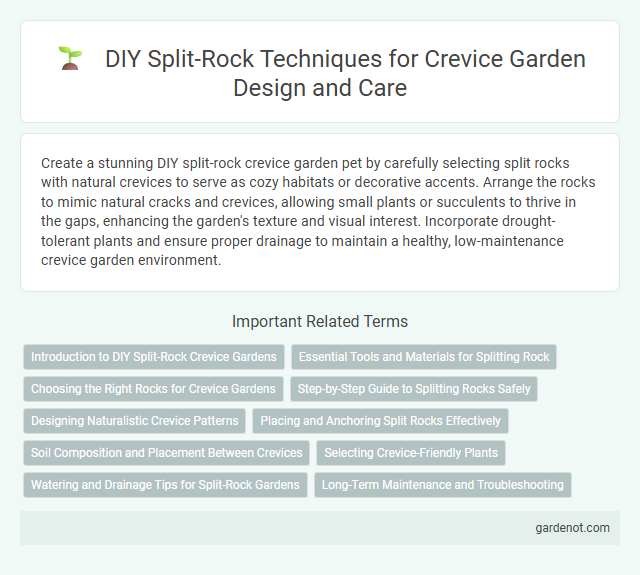Create a stunning DIY split-rock crevice garden pet by carefully selecting split rocks with natural crevices to serve as cozy habitats or decorative accents. Arrange the rocks to mimic natural cracks and crevices, allowing small plants or succulents to thrive in the gaps, enhancing the garden's texture and visual interest. Incorporate drought-tolerant plants and ensure proper drainage to maintain a healthy, low-maintenance crevice garden environment.
Introduction to DIY Split-Rock Crevice Gardens
DIY split-rock crevice gardens offer a unique way to create naturalistic, low-maintenance landscapes that mimic alpine environments. By carefully arranging split rocks with narrow crevices, you can cultivate drought-tolerant plants such as sedums, alpine asters, and dwarf conifers that thrive in well-drained soils. This method enhances biodiversity while requiring minimal watering and soil amendments, making it ideal for xeriscaping and rock garden enthusiasts.
Essential Tools and Materials for Splitting Rock
For a successful DIY split-rock project in a crevice garden, essential tools include a hammer, chisel, safety goggles, and sturdy gloves to ensure precision and safety during the splitting process. High-quality materials such as dense, weather-resistant rocks like granite or basalt are ideal for durability and natural erosion resistance. Using a masonry drill and wedges can facilitate controlled splitting, producing clean, functional rock pieces for the garden design.
Choosing the Right Rocks for Crevice Gardens
Selecting the right rocks for a DIY split-rock crevice garden involves prioritizing local or natural stone types such as slate, limestone, or sandstone, which offer durability and aesthetic appeal. Rocks should have irregular shapes and sharp edges to create authentic crevices and enhance plant rooting spaces. Consider stone porosity and color to match the garden's microclimate and desired visual harmony.
Step-by-Step Guide to Splitting Rocks Safely
Begin by selecting appropriate rocks with natural fissures for easier splitting, then mark the desired split line using a chalk or pencil. Use a chisel and hammer, positioning the chisel along the marked line and tapping gently to create a groove; repeat the process evenly around the rock. Employ safety gear such as gloves, goggles, and sturdy boots throughout the procedure to prevent injury from flying debris and sharp edges.
Designing Naturalistic Crevice Patterns
Designing naturalistic crevice patterns for a DIY split-rock garden involves arranging rocks with varying sizes and irregular shapes to mimic natural fissures. Incorporate angular stones positioned with narrow gaps to create microhabitats for alpine plants and succulents. Using a mix of vertical and horizontal placements enhances water drainage and replicates genuine geological crevices.
Placing and Anchoring Split Rocks Effectively
Placing and anchoring split rocks effectively in a Crevice garden requires selecting stable, flat surfaces to ensure secure positioning. Embed the base of each rock into the soil or gravel substrate to prevent shifting, and use smaller stones or natural clay as fillers to lock the rocks in place. Proper anchoring enhances structural integrity, supports plant roots, and maintains the garden's aesthetic balance.
Soil Composition and Placement Between Crevices
Split-rock (Pleiospilos nelii) thrives in well-draining, sandy or gritty soil rich in mineral content, mimicking its native arid habitat. Optimal placement involves positioning between crevices where moisture is minimal, and air circulation is maximized to prevent root rot. Ensuring soil composition includes a mix of coarse sand, perlite, and a small amount of organic matter supports healthy growth and natural blooming.
Selecting Crevice-Friendly Plants
Choosing crevice-friendly plants for a DIY split-rock garden involves prioritizing drought-tolerant, shallow-rooted species such as Sedum, Sempervivum, and Saxifraga. These plants thrive in narrow gaps with minimal soil and require excellent drainage to prevent root rot. Incorporating native alpine or rock garden plants enhances long-term sustainability and visual appeal.
Watering and Drainage Tips for Split-Rock Gardens
Split-rock (Pleiospilos nelii) thrives in well-drained soil, requiring infrequent watering to prevent root rot. Ensure the crevice garden features gritty, sandy soil with excellent drainage and avoid water accumulation around the plant base. Water only when the top inch of soil is dry, typically every two to three weeks, adapting frequency based on seasonal humidity and temperature.
Long-Term Maintenance and Troubleshooting
Split-rock plants (Pleiospilos nelii) in a crevice garden require well-drained soil and minimal watering to prevent root rot over time. Inspect regularly for signs of pests such as mealybugs and remove affected leaves promptly to maintain plant health. Ensuring adequate sunlight and avoiding overwatering are critical for the long-term survival and vibrant growth of split-rock succulents.
DIY split-rock Infographic

 gardenot.com
gardenot.com